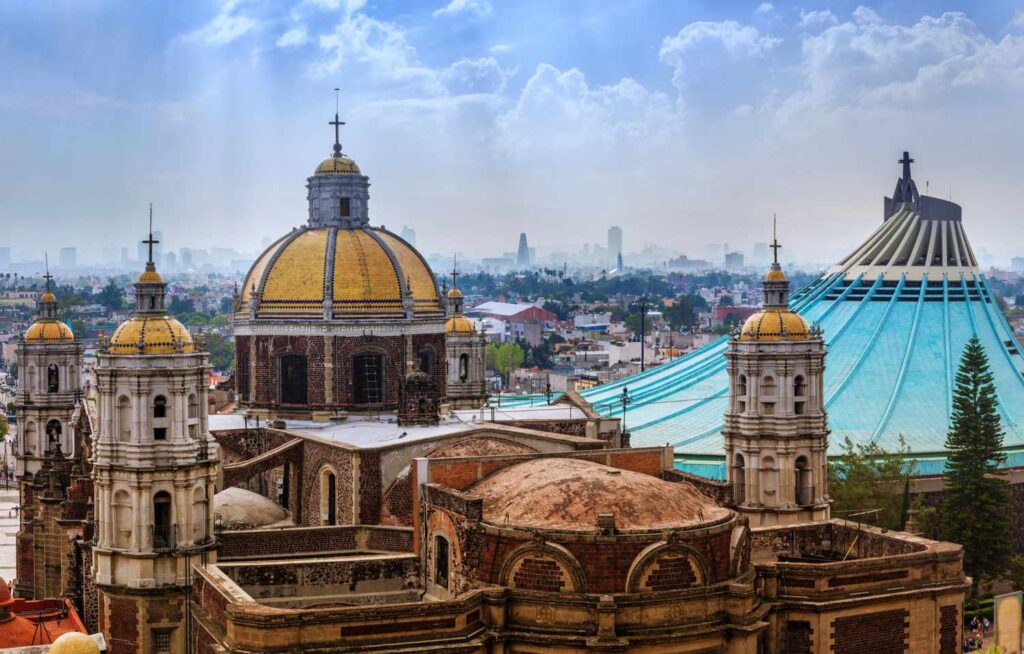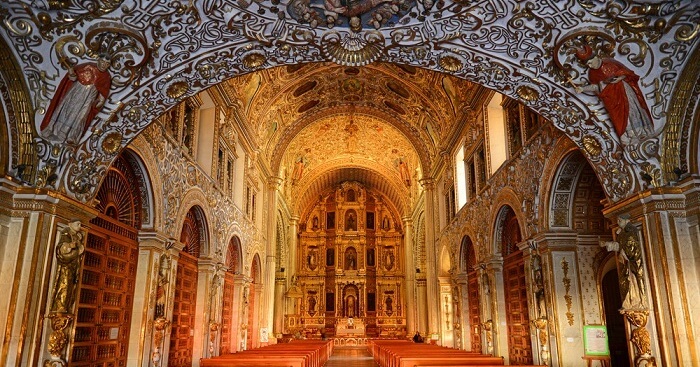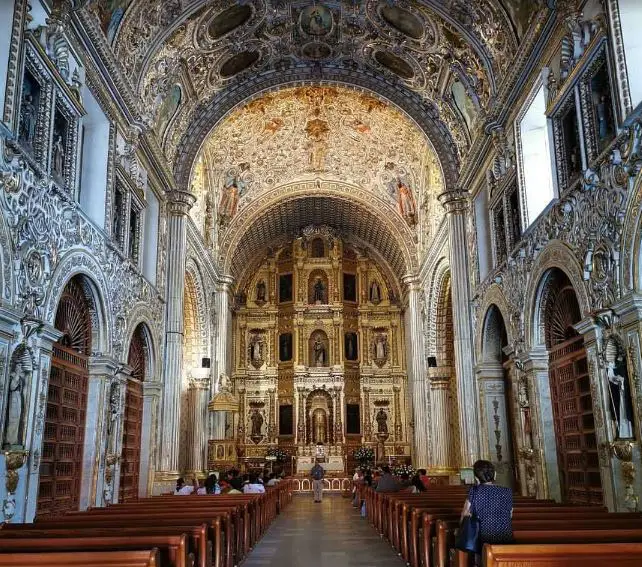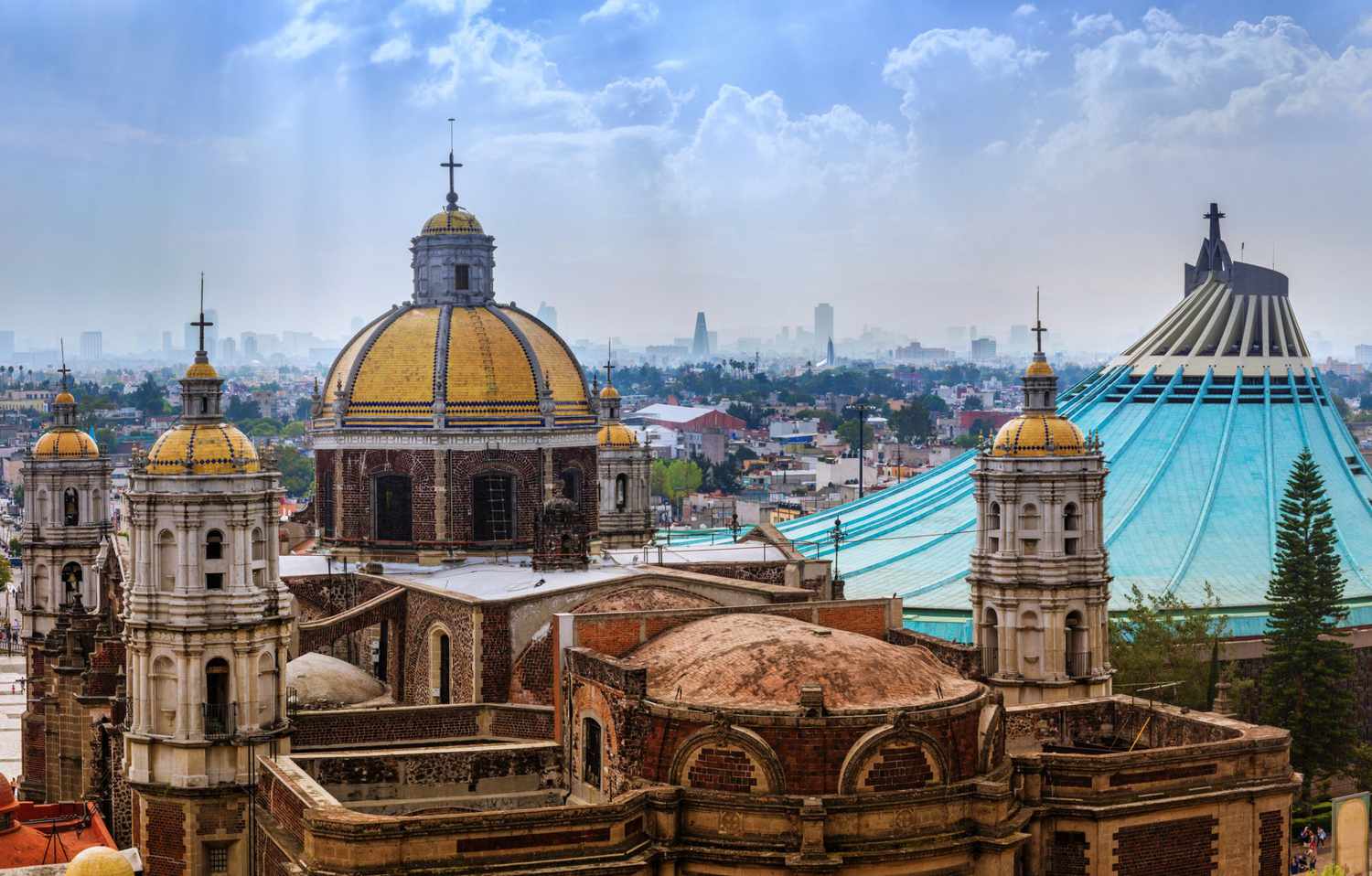Have you ever wondered about the magnificent cathedrals of Mexico? The country is known for its rich history and vibrant culture, and one of the most striking aspects of this is its awe-inspiring architecture. In this article, we’ll delve into the beauty and grandeur of Mexico’s cathedrals, exploring their historical significance and architectural features. By the end, you’ll be itching to pack your bags and embark on a journey to Mexico to witness these marvels firsthand!
Mexico is a popular destination for tourists around the world, and it’s no surprise why. From its vibrant cities to its stunning natural landscapes, the country has something to offer for every type of traveler. But one aspect that often gets overlooked is its extraordinary cathedrals. These magnificent structures stand as testaments to Mexico’s rich religious and cultural heritage. Combining elements of Spanish colonial architecture with indigenous influences, these cathedrals are truly unique and offer visitors a glimpse into the past. Whether you’re a history buff or simply appreciate the beauty of architecture, exploring the cathedrals of Mexico is an experience like no other. So, get ready to learn more about these architectural wonders and embark on a journey to discover their magnificence!

The Influences and Origins of Mexican Cathedrals
Mexico’s cathedrals are not only magnificent architectural marvels, but they also hold significant historical, cultural, and spiritual importance. These awe-inspiring structures are a testament to the melding of various influences and the rich history of the country. In this article, we will explore the influences and origins of Mexican cathedrals, the iconic cathedrals in Mexico, the magnificent interiors and structural marvels of these cathedrals, their historical and spiritual significance, their cultural impact, the challenges in preserving them, the stories and legends surrounding them, the role they play as cultural landmarks, the visitors’ experience, and the future and legacy of Mexican cathedrals.
The Spanish Colonial architectural style
One of the primary influences on Mexican cathedrals is the Spanish Colonial architectural style. As a result of Spanish colonization, Mexico assimilated various architectural elements from the Spanish Empire. This unique blend of European and indigenous styles gave rise to the distinctive architecture seen in Mexican cathedrals. The Spanish Colonial style can be characterized by its use of ornamental facades, bell towers, dome-shaped roofs, and grandiose interiors.
The indigenous influences on Mexican cathedrals
While Spanish Colonial architecture played a significant role in the construction of Mexican cathedrals, indigenous influences also left their mark. Indigenous craftsmanship and architectural traditions were incorporated into the design and construction process, resulting in a fusion of styles. The use of local materials, such as volcanic stone and indigenous wood, gave Mexican cathedrals a distinct character that sets them apart from cathedrals in other parts of the world.
The use of local materials in construction
Mexican cathedrals stand as a testament to the ingenuity and resourcefulness of the people involved in their construction. Local materials were used extensively, not only for economic reasons but also to showcase the natural beauty of the region. Cantera stone, a type of volcanic rock, was widely utilized for its durability and aesthetic appeal. Indigenous woods, such as cedar and mahogany, were often employed in the intricate carvings and decorations found within the cathedrals.
The Most Iconic Cathedrals in Mexico
Mexico is home to numerous magnificent cathedrals that stand as testaments to the country’s rich heritage. These cathedrals showcase a variety of architectural styles and cultural influences. Here are some of the most iconic cathedrals in Mexico:
The Metropolitan Cathedral of Mexico City
Located in the heart of Mexico City, the Metropolitan Cathedral is not only one of the most iconic cathedrals in Mexico but also one of the largest in the Americas. Its construction began in 1573 and continued for over three centuries. The cathedral boasts a unique blend of architectural styles, including Spanish Renaissance and Baroque influences. With its towering bell towers, grand facades, and stunning interior, the Metropolitan Cathedral is a must-visit for any traveler exploring Mexico City.
The Guadalajara Cathedral
Located in the city of Guadalajara, the Guadalajara Cathedral is another iconic Mexican cathedral. Its construction began in the 16th century and continued for several centuries, resulting in a mix of architectural styles, including Gothic, Moorish, and Neoclassical elements. The cathedral’s twin towers and intricately designed facade make it a striking sight to behold. Inside, visitors can admire the ornate altars, religious artwork, and stunning stained glass windows.
The Puebla Cathedral
Situated in the colonial city of Puebla, the Puebla Cathedral is renowned for its magnificent architecture and historical significance. Constructed in the 16th century, the cathedral showcases a stunning example of Spanish Baroque architecture. Its colorful domes, intricate stone carvings, and ornate decoration make it a true masterpiece. The Puebla Cathedral also houses an impressive collection of religious art and artifacts.
The Merida Cathedral
Located in the city of Merida, the Merida Cathedral is a prime example of Mexican Baroque architecture. This cathedral’s notable features include its grand facade, richly ornamented interiors, and impressive bell towers. The Merida Cathedral serves as a symbol of the city’s cultural and religious heritage and is a popular destination for both locals and tourists.

The Magnificent Interiors of Mexican Cathedrals
Stepping inside a Mexican cathedral is like entering a world of beauty and serenity. The interiors of these cathedrals are adorned with intricate altars, religious artwork, and stunning stained glass windows.
The intricate altars and religious artwork
One of the defining features of Mexican cathedrals is the presence of intricate altars. These altars, made with gold leaf and adorned with sculptures and paintings, serve as focal points for religious worship. They often depict scenes from the Bible, important religious figures, and saints. The craftsmanship and attention to detail in these altars are truly remarkable, showcasing the skill and devotion of the artisans who created them.
The stunning stained glass windows
Stained glass windows are another highlight of Mexican cathedrals. These vibrant works of art allow natural light to filter through, creating a mesmerizing display of colors within the cathedral. The scenes depicted on stained glass windows often portray religious narratives or symbols, adding to the overall spiritual ambiance of the space. Visitors to Mexican cathedrals can marvel at the beauty and intricate details of these stained glass masterpieces.
The grandiose organ pipes
In addition to altars and stained glass windows, Mexican cathedrals often feature grandiose organ pipes. These majestic instruments, usually located in the choir loft, add an element of grandeur to the cathedrals’ interiors. The sound of the organ reverberating throughout the cavernous space creates a sense of awe and reverence. Many cathedrals in Mexico host organ concerts, allowing visitors to experience the full glory and power of these impressive musical instruments.
The Structural Marvels of Mexican Cathedrals
The sheer scale and architectural details of Mexican cathedrals make them true structural marvels. From colossal bell towers and facades to intricate stone carvings and sculptures, these cathedrals leave a lasting impression on all who visit.
The colossal bell towers and facades
One cannot help but be awestruck by the colossal bell towers and facades of Mexican cathedrals. These towering structures reach towards the heavens, symbolizing the connection between the divine and the earthly. The facades of Mexican cathedrals are often adorned with intricate carvings, sculptures, and ornamental details, showcasing the skill and craftsmanship of the builders. Each cathedral’s facade tells a story, reflecting the unique history and cultural heritage of the region.
The intricate stone carvings and sculptures
Mexican cathedrals are renowned for their intricate stone carvings and sculptures, which can be found both inside and outside the buildings. The skilled artisans who created these masterpieces left no detail untouched, resulting in breathtaking works of art. From the intricate floral motifs to the finely carved statues of saints and religious figures, every element reflects the dedication, skill, and devotion of the craftsmen.
The impressive domes and vaulted ceilings
Mexican cathedrals often feature impressive domes and vaulted ceilings that create a sense of grandeur and space. The architectural ingenuity required to construct these structures is remarkable, considering the time and resources available during their construction. The domes, often embellished with stucco and decorative painting, soar above visitors’ heads, drawing their gaze towards the heavens. The vaulted ceilings, with their intricate patterns and arches, add to the overall sense of awe and reverence within the cathedrals.

The Historical Significance of Mexican Cathedrals
Mexican cathedrals bear witness to significant historical events and reflect the country’s complex past. They played a crucial role in the Spanish conquest, have preserved cultural heritage, and are connected to Mexican independence.
The role of cathedrals in the Spanish conquest
During the Spanish conquest, cathedrals were both symbols of religious dominance and centers of power. The construction of cathedrals was often one of the first priorities for the Spanish conquerors, as they sought to establish their authority and convert the indigenous population to Catholicism. The imposing presence of cathedrals served as a constant reminder of Spanish rule and religious control.
The preservation of cultural heritage
Despite their association with Spanish colonization, Mexican cathedrals have also played a significant role in preserving the country’s cultural heritage. Through the integration of indigenous craftsmanship and use of local materials, these cathedrals became a unique blend of European and indigenous styles. They served as important centers for art and culture, preserving indigenous techniques and traditions that might have otherwise been lost.
The connection to Mexican independence
Mexican cathedrals also have a connection to the country’s struggle for independence. During the Mexican War of Independence in the early 19th century, these cathedrals became gathering places for revolutionary leaders and their followers. Services and speeches held within the cathedrals served as rallying points for the fight against Spanish rule. Today, these cathedrals stand as reminders of the courage and determination of those who fought for Mexico’s independence.
The Spiritual Significance of Mexican Cathedrals
Mexican cathedrals are not just architectural wonders; they hold deep spiritual significance for the Mexican people. They serve as important religious spaces, facilitate community gatherings, and are filled with symbolism and rituals.
The importance of cathedrals in Mexican religious practices
Mexican cathedrals are at the heart of religious life in the country. They serve as places of worship, where individuals can connect with their faith, seek guidance, and find solace. The grandeur and beauty of the cathedrals create an atmosphere conducive to contemplation and prayer. Masses, religious processions, and sacraments are conducted within these sacred spaces, bringing together believers in the shared experience of worship.
The role of cathedrals in community gatherings
In addition to their religious significance, Mexican cathedrals also play an important role in community life. They serve as gathering spaces for important events such as weddings, funerals, and baptisms. Community celebrations and festivals often take place within the grounds of cathedrals, bringing together people from various walks of life. These cathedrals act as a focal point for community cohesion and social interaction, fostering a sense of unity and belonging.
The symbolism and rituals within cathedrals
Mexican cathedrals are filled with symbolism and rituals that deepen the spiritual experience for believers. Each cathedral is dedicated to a specific saint or religious figure, and their images can be found throughout the space. The layout and architecture of the cathedrals also often follow specific religious symbolism, such as the placement of the altar at the east end, symbolizing the rising sun and the resurrection of Christ. Rituals such as Holy Communion, confession, and baptism are performed within the cathedrals, connecting individuals to centuries-old traditions.

The Cultural Impact of Mexican Cathedrals
Mexican cathedrals have had a profound impact not only on the country’s architecture but also on its art, literature, local economies, tourism, and the dissemination of Catholicism.
The influence on Mexican art and literature
Mexican cathedrals have been a source of inspiration for artists and writers throughout history. The grandeur and beauty of these structures have been depicted in countless paintings, murals, and literary works. Mexican art and literature often incorporate elements of the cathedrals, showcasing their significance in shaping the cultural identity of the country.
The impact on local economies and tourism
Mexican cathedrals attract countless visitors each year, contributing significantly to local economies and tourism. These architectural wonders are major tourist attractions, drawing visitors from around the world who are captivated by their beauty and rich history. The presence of these tourists supports local businesses, creating jobs and boosting the economy in the surrounding areas.
The dissemination of Catholicism in Mexico
Mexican cathedrals have played a crucial role in the dissemination of Catholicism throughout the country. As centers of worship and religious education, these cathedrals have served as important hubs for spreading the teachings of the Catholic Church. They have played an instrumental role in shaping the religious landscape of Mexico and in fostering a strong Catholic identity among the Mexican people.
The Challenges in Preserving Mexican Cathedrals
Preserving Mexican cathedrals is no small task. These historic structures face numerous challenges, including the effects of natural disasters, ongoing maintenance and restoration projects, and striking the balance between preservation and modernization.
The effects of natural disasters on cathedrals
Mexico is prone to natural disasters, including earthquakes and hurricanes, which pose a significant threat to the preservation of its cathedrals. These disasters can cause structural damage and lead to the loss of invaluable artifacts and artworks housed within the cathedrals. Efforts are underway to fortify and strengthen these structures to withstand future disasters and ensure their longevity.
The ongoing maintenance and restoration projects
Preserving Mexican cathedrals requires ongoing maintenance and restoration projects. The ravages of time, pollution, and environmental factors take a toll on these aging structures. Dedicated teams of conservationists and experts work tirelessly to repair and restore the cathedrals, ensuring that they remain standing for future generations to admire and appreciate.
The balance between preservation and modernization
Preserving Mexican cathedrals while also accommodating the needs of modern society presents a unique challenge. Striking the right balance between preservation and modernization is crucial to ensure that these cathedrals remain relevant and accessible to people in the present day. Efforts are made to incorporate modern technologies, such as lighting and sound systems, without compromising the integrity and historical significance of the cathedrals.

The Stories and Legends Surrounding Mexican Cathedrals
Mexican cathedrals are not just buildings; they are steeped in stories and legends that add to their allure and mystique. Tales of hidden treasure, ghostly encounters, miracles, and divine interventions have become a part of the lore surrounding these magnificent structures.
The tale of the hidden treasure under a cathedral
Legends often tell of hidden treasure buried beneath the cathedrals’ foundations. These tales capture the imagination, enticing treasure hunters and adventurers to embark on quests to uncover the hidden riches. While there may not be substantial evidence to support these legends, they add an element of mystery and intrigue to the cathedrals’ histories.
The ghost stories and paranormal experiences
Many Mexican cathedrals are said to be haunted, with stories of ghostly apparitions and eerie experiences. Visitors and locals have reported inexplicable phenomena, such as strange sounds, cold spots, and unexplained movements. These ghost stories add a layer of mystery to the cathedrals, captivating those who are drawn to the supernatural.
The legends of miracles and divine interventions
It is not uncommon to hear stories of miracles and divine interventions associated with Mexican cathedrals. These tales often involve religious artifacts, such as statues or relics, that are believed to possess healing or miraculous powers. These legends serve as a testament to the deep faith and spiritual devotion of the Mexican people.
The Cathedrals as Cultural Landmarks of Mexico
Mexican cathedrals are more than just religious or architectural sites; they serve as cultural landmarks that symbolize the country’s identity and heritage. They have received recognition as UNESCO World Heritage Sites, play a significant role in national and local identity, and are centers of celebration during religious festivals and events.
The recognition as UNESCO World Heritage Sites
Several Mexican cathedrals have been recognized as UNESCO World Heritage Sites, further emphasizing their cultural and historical importance. This recognition highlights the need to protect and preserve these architectural treasures for future generations to appreciate. The inscription as World Heritage Sites also draws attention to the rich cultural heritage of Mexico as a whole.
The role of cathedrals in national and local identity
Mexican cathedrals hold a special place in both national and local identity. They are symbols of the country’s cultural heritage and serve as reminders of its history and traditions. Cathedrals often feature prominently in local pride and identity, with communities taking great pride in the preservation and upkeep of these landmarks.
The celebration of religious festivals and events
Religious festivals and events play a vital role in Mexican culture, and cathedrals serve as central locations for these celebrations. Festivals such as Semana Santa (Holy Week) and Dia de los Muertos (Day of the Dead) are marked by processions, religious ceremonies, and vibrant cultural displays. Mexican cathedrals become focal points for these events, where the community gathers to celebrate and honor their faith.
The Visitors’ Experience of Mexican Cathedrals
For visitors from around the world, stepping into a Mexican cathedral is an awe-inspiring experience. The grandeur, history, and spiritual aura create a lasting impression that stays with them long after they leave.
The awe-inspiring first impression upon entering
The moment you step through the doors of a Mexican cathedral, you are transported to a realm of beauty and tranquility. The soaring ceilings, ornate decorations, and interplay of light and shadow create a sense of wonder and awe. The sheer scale of the cathedrals, combined with their architectural details, leaves a lasting impression on all who enter.
The guided tours and educational programs
To fully appreciate the history and significance of Mexican cathedrals, guided tours and educational programs are available for visitors. These tours provide insights into the construction techniques, architectural styles, and cultural contexts of the cathedrals. Knowledgeable guides share stories and anecdotes, helping visitors to develop a deeper understanding and appreciation for these magnificent structures.
The vibrant atmosphere during religious celebrations
Attending a religious celebration within a Mexican cathedral is a truly immersive experience. The vibrant atmosphere, filled with music, prayers, and the devotion of the worshippers, creates a sense of unity and spiritual energy. Visitors have the opportunity to witness firsthand the deep faith and cultural traditions that are an integral part of Mexican society.
The Future of Mexican Cathedrals
The preservation and continued relevance of Mexican cathedrals are of utmost importance. Efforts are being made to ensure their preservation, integrate modern technologies, and maintain their significance in the face of a changing world.
The preservation and restoration efforts
Preserving Mexican cathedrals requires ongoing preservation and restoration efforts. Architects, conservationists, and experts work tirelessly to repair and maintain these historic structures, preventing further deterioration and ensuring their longevity. Through these efforts, future generations will be able to appreciate the beauty and historical value of Mexican cathedrals.
The integration of modern technologies
As the world becomes increasingly technologically advanced, Mexican cathedrals are also embracing modern technologies to enhance the visitor experience. Lighting and sound systems are being installed to showcase the architectural details and create immersive environments for concerts, religious services, and cultural events. The integration of these technologies aims to strike a balance between tradition and modernity.
The continued relevance and importance
Mexican cathedrals remain pillars of faith and cultural significance, even in today’s rapidly changing world. They continue to play a central role in religious life, serve as gathering places for communities, and attract visitors from around the world. The continued relevance and importance of these cathedrals ensure their place as enduring symbols of faith, craftsmanship, and the rich heritage of Mexico.
The Legacy of Mexican Cathedrals
Mexican cathedrals have left an indelible mark on the country’s architectural styles, inspired future generations, and serve as enduring symbols of faith and craftsmanship.
The impact on architectural styles in Mexico
The architectural styles and techniques employed in the construction of Mexican cathedrals have had a profound impact on subsequent architectural endeavors in the country. The fusion of European and indigenous styles, the use of local materials, and the intricate craftsmanship have influenced Mexican architecture for centuries. Elements of Mexican cathedrals can be seen in the design of churches, government buildings, and private residences throughout the country.
The inspiration for future generations
Mexican cathedrals stand as beacons of inspiration for future generations of architects, artists, and craftsmen. The creativity, skill, and devotion of those who designed and built these cathedrals serve as a reminder of what can be achieved through passion and dedication. The legacy of Mexican cathedrals continues to inspire individuals to create beautiful and meaningful works of art and architecture.
The enduring symbol of faith and craftsmanship
Above all else, Mexican cathedrals stand as enduring symbols of faith and craftsmanship. They represent the deep religious devotion of the Mexican people and the remarkable skill of the artisans who brought these structures to life. Mexican cathedrals are a testament to the power of human creativity, the enduring spirit of faith, and the capacity to create lasting beauty.
Conclusion
The cathedrals of Mexico are not just magnificent structures; they are also repositories of history, culture, and spirituality. From their awe-inspiring architecture to their cultural significance, these cathedrals continue to inspire and captivate visitors from around the world. As their stories and legends intertwine with the present, the cathedrals of Mexico stand as enduring symbols of faith, craftsmanship, and the rich heritage of the country. Through their preservation, celebration, and appreciation, the legacy of Mexican cathedrals will continue to shape and inspire generations to come.
